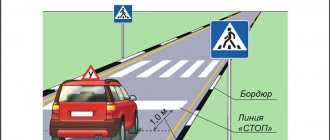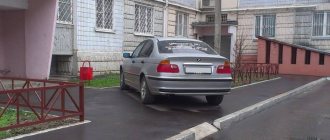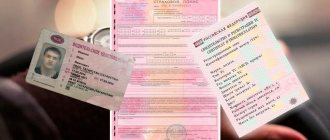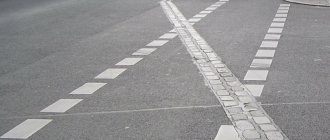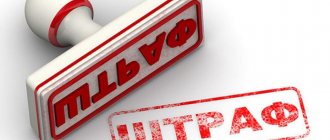At night, you can see “one-eyed” cars on the roads. One of the headlights has stopped shining, and from the reflections in the distance it is impossible to understand which vehicle is moving towards you. This is especially unpleasant on country roads, when on a narrow strip of asphalt it is not clear whether it is a motorcyclist or a tractor standing on the side of the road. And if this is a car, then it’s difficult to understand from one headlight how far away it is and on which side its body is located. All this makes oncoming traffic difficult. Is it legal to drive a faulty car and is it possible to take such technical liberties yourself from time to time?
See everything. Why does a car need four headlights? More details
Checking the headlights before driving
If the option corresponds to when the headlight does not work at all, that is, it does not shine or does not shine as it should, then there is a clear violation of the “Basic provisions for the approval of vehicles...”. That is, the car should not have been on the road with such defects. This is indicated in clause 3.3 “List of malfunctions and conditions under which the operation of vehicles is prohibited”
External lighting devices and reflectors do not work in the prescribed mode or are dirty.
As a result, this fine will be issued under Article 12.5 of the Code of Administrative Offenses of the Russian Federation, Part 1 “Driving a vehicle in the presence of malfunctions or conditions...”. Now let's figure out what kind of fine can be issued for faulty headlights (dimensions) or even if they are simply dirty.
What is considered a violation
There are many situations when you need to use low beam:
| Times of Day | Situation |
| Night time | In cities, towns, etc., with road lighting |
| Temporarily 150 meters in front of an oncoming car | |
| Daytime | In populated areas |
| Outside populated areas |
The violation itself is expressed as follows:
- low beam is not on;
- Instead, either side lights or high beams work.
Fine for a non-working headlight (headlights, dimensions)
First, let's quote part 1 of Article 12.5 of the Code of Administrative Offenses of the Russian Federation, it will clarify a lot for us:
Driving a vehicle in the presence of malfunctions or conditions under which, in accordance with the “Basic Provisions ... is prohibited ...”, entails a warning or the imposition of an administrative fine in the amount of 500 rubles
If you continue to study Article 12.5 of the Code of Administrative Offenses of the Russian Federation, you may come across Part 3. It talks about the non-compliance of lighting devices with the prescribed requirements. If the headlights simply do not work, and have not been subjected to unacceptable modifications, then this does not apply to their inconsistencies, which means this part of the article cannot be applied. Here we can also say that Article 27.13 of the Code of Administrative Offenses does not apply to Part 1 of Article 12.5. That is, they cannot detain the car or put it in the impound lot. The driver will be able to continue driving to repair the breakdown. In this case, the driver may be issued a second fine, but only after 24 hours.
Here it is also necessary to pay attention to the possibility of issuing a fine for dirty lighting fixtures. The degree of this contamination is identified in an unclear way and with the help of what instruments. So it will be difficult to argue about this with the traffic police officers in this case. However, this is relevant for the case when at night the car’s rear license plate illumination is dirty, and because of this license plate itself is not visible. In this case, a fine may also be issued for an unreadable license plate that is not visible from 20 meters. More details about this in the article “Fine for dirty numbers”.
Punishment measures for offenses
The existing fines provided for non-functioning low beams can be received by any motorist. Trivial inattention or unwillingness to simply fix existing problems can not only lead to a fine, but also create an emergency situation.
The penalty provided for not turning on the low beam is a fine of 500 rubles . This means that if a motorist drives a vehicle without turning on the low beam, he will have to pay an administrative fine in the amount of the above-mentioned 500 rubles. In principle, there is a possibility that the driver will be able to get away with just a verbal warning.
How to avoid a fine for a broken headlight
The best option to avoid a fine is to do the following. Initially, communicate politely with government officials and keep yourself in control. Secondly, the driver must emphasize that he himself is surprised that the headlight does not work. Since the lamp apparently burned out during the trip. When the trip just started, the headlights or headlight were working... Thirdly, Article 12.5 of the Code of Administrative Offenses of the Russian Federation, Part 1 provides for a warning. Fourthly, if you have not been held administratively liable for 6 months, then be sure to say so. As a result, ask the inspector to take all factors into account and issue a warning about the violation, rather than issuing a fine. Here I would like to immediately say that you should not abuse such trust, since the driver himself should be primarily interested in eliminating the breakdown. His health and life depend on it. This is what we will talk about next.
Deadlines for payment of fines
You can make a payment within:
If you exceed the twenty-day grace period, you will have to pay 100% of the penalty amount specified in the decree.
If you made a payment after the maximum period provided by law, you will be held liable under Article 20.25 of the Code. In this case, the fine will be doubled and you may face forced labor or arrest.
Do you know that you violated traffic rules and are not going to appeal the decision on punishment? In this case, you must pay the amount of the fine within the first 20 days after the court or other authorized body makes the relevant decision. You can reduce the fine by 50%.
Payment is made through a branch of any bank, by transfer via mobile or online banking (the service is available to owners of a bank account or plastic card).
Is it possible to continue driving with a non-working (not lit) headlight (tail light)
The situation with such a malfunction in practice and in law is very interesting. It seems that Article 27.13 of the Code of Administrative Offenses of the Russian Federation “Detention of a Vehicle” does not provide for the detention of a car for such a malfunction. However, there is order 664, on the “Administrative Regulations...”. It contains very interesting recommendations for a police inspector. They are based precisely on the requirements for prohibiting the operation of a vehicle according to the “List of faults and conditions under which the operation of a vehicle is prohibited”
68. If it is revealed that the driver is driving a vehicle with unlit (missing) headlights and tail lights in the dark or in conditions of insufficient visibility, or the driver’s windshield wiper is inoperative during rain or snow <1>, the employee demands that the vehicle stop moving until it is fixed related faults or conditions. At the same time, parking the vehicle should not pose a threat to road safety. <1> Paragraph 2 of clause 2.3.1 of the Traffic Rules. The imposition of an administrative penalty does not relieve the driver from fulfilling the duty for which the administrative penalty was imposed <2>. <2> Part 4 of Article 4.1 of the Code. If the driver fails to comply with the employee’s legal request to stop moving the vehicle until the faults or conditions specified in paragraph one of this paragraph are eliminated, the employee initiates a case for an administrative offense provided for in Part 1 of Article 19.3 of the Code.
That is, the driver may well be “stuck” all night if he doesn’t fix the headlight and it’s dark outside. Indeed, in this case, conditions when rear lights are not needed will arise only during daylight hours. Thus, a malfunction of the headlight can lead to a whole chain of troubles.
How to use fog lights
A motorist can use fog lighting as the main lighting when driving during daylight hours. However, clause 19.4 regulates that fog lights are also used when visibility of the space is limited while driving a vehicle.
This lighting can be used in conjunction with the light of the main headlights intended for low or high beam lighting. Clause 19.5 of the traffic rules allows the use of fog lights at night on roads not equipped with lighting. It is also interesting to note the fact that these devices can be used during the day instead of headlights intended for low beam lighting.
Thus, using a vehicle during the day with fog lights on is not a sanctioned offense. For this reason, motorists need not worry about receiving a ticket for their lights.
Is it possible to pay a fine for a non-working headlight or clearance with a 50 percent discount?
Since 2021, drivers who violate traffic rules, but are ready to repent and pay a fine, have the opportunity to pay this same fine with a 50 percent discount. For the sake of fairness, it should be noted that such a discount can not be obtained for every fine, but only for “non-serious” forms of traffic violations. So Article 12.5 falls under the same option when the fine can still be paid with a discount of 50 percent, that is, half as much. To do this, you must pay the traffic police fine from the time it appears in the database, but no later than 20 days from the date of its commission. More details about this in the article “How to pay a fine with a 2-fold discount.”
○ Rules for using low beams.
In 2010, amendments were made to the traffic rules, obliging drivers to turn on their lights during the day when driving. Clause 19.5 of traffic regulations:
- "19.5. During daylight hours, all moving vehicles must have low-beam headlights or daytime running lights turned on for the purpose of identifying them.”
That is, now, regardless of the time of day, the car should be illuminated. So, what lighting elements should be turned on during the daytime? Traffic regulations give three possible answers:
- Low beam headlights.
- Daytime running lights installed in accordance with GOST.
- Fog lights.
Any of them is enough for the rules to be followed. The dimensions are not suitable, as they do not provide enough bright lighting. Not every car, especially older models, has daytime running lights. Therefore, those who wish can retrofit their car with it themselves or at a service center, subject to obtaining permission from the State Traffic Safety Inspectorate and complying with GOST requirements, establishing:
- In front of the car.
- Not lower than 25 cm from the ground and not higher than 1.5 meters.
- At least 60 cm between lights.
- No more than 40 cm from the edge of the car body.
Despite the apparent cost, such retrofitting will save time and money in the future. They put less load on the car’s energy system, which is especially important for older models. The driver can choose which lamps to equip the lights with: halogen, incandescent or LED. The latter are the most popular option among car owners.
Summarizing the topic “Fine for non-working headlight(s)”
If a headlight or headlights on a car do not work, then several conclusions can be drawn at once. First of all, it's simply not safe. Especially in the dark, when only one headlight works. If the second one suddenly burns out, it can lead to an accident at high speed. This means it jeopardizes the health and life of the driver and passengers, if there are any in the car. One can only wonder why Article 27.13 of the Code of Administrative Offenses of the Russian Federation does not provide for the detention of such vehicles in the dark. After all, this is dangerous not only for the driver and passengers of a vehicle with a malfunction, but also for the road users around it. Secondly, if the headlights or headlights do not work, then this simply threatens with administrative liability in the form of a warning or a fine. There is nothing good in this either, it is a waste of nerves, time, money. That is why try to monitor the serviceability of the headlights on your car.
Questions and answers on the topic “Fine for non-working headlight(s)”
Question: Can they issue a fine for the fact that 1 headlight on a car does not work? Answer: Yes, they can. This is a warning or a fine of 500 rubles.
Question: Can a car be detained for a parking fine if the headlight is not working? Answer: No, Article 27.13 of the Code of Administrative Offenses of the Russian Federation does not provide for this, but they may force you to repair the headlight right on the spot or prohibit further movement.
Video about a fine for a non-working headlight
For those who do not like to read, we have prepared a video that fully reflects the essence of the article and talks about a possible fine for a non-working headlight.
How to appeal a decision?
You should file a complaint with the district judge or the head of the traffic police who made the decision on the punishment only if you believe that you did not violate the traffic rules.
Consult with a qualified auto attorney to find out what your chances are of challenging the judgment and getting relief from paying the fine.
A written complaint must be submitted within 10 days. The countdown begins from the moment you receive the relevant decision.
To appeal the decision to prosecute you, you need to prove that you did not violate any traffic rules. For this purpose, it is possible to use documents, photographs, video materials (for example, a recording from a video recorder), as well as refer to the testimony of witnesses.
For example, if you have been issued a ticket for using LED headlights, but the design of your vehicle requires them, you have the right to go to court and appeal the fine.
The complaint must be supplemented by documents for the machine, which indicate the types of lighting devices that can be built in according to the manufacturer’s recommendations.
If you were stopped because of one non-working headlight and issued a fine, but you were heading to the service station, which was reported to the inspector, you also have the right to challenge this decision.
The complaint can be supplemented with a receipt from the service station confirming that the problem was corrected on the day the report was drawn up.
If you have difficulty filing a complaint or asserting your rights, contact a qualified auto lawyer. It will not only help protect your interests, but will also restore the ten-day period for challenging the decision if it was missed for a good reason.
